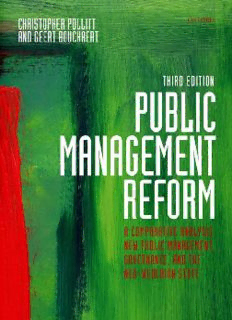Table Of ContentPublic Management Reform
This page intentionally left blank
Public Management
Reform
A Comparative Analysis—New Public
Management, Governance, and the
Neo-Weberian State
THIRD EDITION
Christopher Pollitt
and
Geert Bouckaert
1
3
GreatClarendonStreet,OxfordOX26DP
OxfordUniversityPressisadepartmentoftheUniversityofOxford.
ItfurtherstheUniversity’sobjectiveofexcellenceinresearch,scholarship,
andeducationbypublishingworldwidein
Oxford NewYork
Auckland CapeTown DaresSalaam HongKong Karachi
KualaLumpur Madrid Melbourne MexicoCity Nairobi
NewDelhi Shanghai Taipei Toronto
Withofficesin
Argentina Austria Brazil Chile CzechRepublic France Greece
Guatemala Hungary Italy Japan Poland Portugal Singapore
SouthKorea Switzerland Thailand Turkey Ukraine Vietnam
OxfordisaregisteredtrademarkofOxfordUniversityPress
intheUKandincertainothercountries
PublishedintheUnitedStates
byOxfordUniversityPressInc.,NewYork
#ChristopherPollittandGeertBouckaert,2011
Themoralrightsoftheauthorshavebeenasserted
DatabaserightOxfordUniversityPress(maker)
Firstpublished2000
Secondeditionpublished2004
Thirdeditionpublished2011
Allrightsreserved.Nopartofthispublicationmaybereproduced,
storedinaretrievalsystem,ortransmitted,inanyformorbyanymeans,
withoutthepriorpermissioninwritingofOxfordUniversityPress,
orasexpresslypermittedbylaw,orundertermsagreedwiththeappropriate
reprographicsrightsorganization.Enquiriesconcerningreproduction
outsidethescopeoftheaboveshouldbesenttotheRightsDepartment,
OxfordUniversityPress,attheaddressabove
Youmustnotcirculatethisbookinanyotherbindingorcover
andyoumustimposethesameconditiononanyacquirer
BritishLibraryCataloguinginPublicationData
Dataavailable
LibraryofCongressCataloginginPublicationData
Dataavailable
TypesetbySPIPublisherServices,Pondicherry,India
PrintedinGreatBritain
onacid-freepaperby
MPGBooksGroup,BodminandKing’sLynn
ISBN 978–0–19–959508–2(Hbk)
ISBN 978–0–19–959509–9(Pbk)
1 3 5 7 9 10 8 6 4 2
Forourparents,
Freda,John,Leen,andMichel
This page intentionally left blank
n PREFACE TO THE THIRD EDITION
Togointoathirdeditionisquiteaseriousstep.Asecondeditionbetokensamodestdegree
ofsuccessinattractingreaderswhohopetofindsomethingusefulorinterestingbetween
thecovers.Butathirdeditionbeginstofeellikeaprocessofinstitutionalization—asifone
hasnowbecomeoneofthestatuesintheparkofpublicmanagementandadministration.
Unlikestatues,however,ourbookwillnotstandstill.Itevolvesalmostdaily,sometimes
inaccordancewithourwishesandatothertimesinatiresomeorannoyingway.Infact
thisthirdedition,whileinhabitingasimilarbroadframeworkofchaptersandappendices,
ishugelydifferentfromthesecond.Somechaptersarecompletelynew,andalltheothers
have undergone extensive rewriting and updating. In the remainder of this preface we
wouldliketoexplainthelogicofthisoverhaul.
Scope
Our subject—comparative management reform—has grown tremendously over the past
coupleofdecades.Ithaschangedsignificantlyevensincethefirsteditionofthisbookwas
beingwritten,in1998–9.Theliteraturehasexpandedfastandthediversityofperspectives
and techniques has also increased. We are delighted that the first two editions of Public
ManagementReform: AComparative Analysis playedtheirpart inthisgrowth.Ithasbeen
oneofthemostwidelycitedpublications,andwehopeandintendthatthisveryexten-
sivelychangedthirdeditionwillcontinuetostimulateandinform.
Wehavestucktothesametwelvecountries(plustheEUCommission)asinthesecond
edition.Thepracticalreasonsforthusrestrictingourfocuswereseveral.Tobeginwith,a
dozenstatesisalreadyalottohandle,inthesenseofbecomingfamiliarwiththedetailsof
their reform histories. Further, in order to minimize misunderstandings and superficial
interpretations, we took an early decision not to include stateswhich neither of ushad
recentlyvisited.Additionally,inonlytwocaseswereneitherofusatleastminimallyable
tounderstandthemother-tongue:ItalyandSweden.InthecaseofItalywewerefortunate
in obtaining the detailed help of a leading Italian scholar, Eduardo Ongaro (see, for
example, Ongaro, 2009). In the case of Sweden, so many documents are published in
English as well as Swedish that we felt somewhat reassured. In every country we also
contactedresidentscholarswhogenerouslyhelpeduscheckourfactsandimpressions(see
Acknowledgements for details). For these various reasons we arrived at our final list of
Australia,Belgium,Canada,Finland,France,Germany,Italy,theNetherlands,NewZeal-
and, Sweden, the United Kingdom, the United States of America, and the European
Commission.Withconsiderableregret,weresistedthetemptinginvitationsfromvarious
partiestoadd(interalia)Brazil,Denmark,Estonia,Japan,andNorwaytoourportfolio.
viii PREFACETO THETHIRD EDITION
Choosing a time period also has implications. As in previous editions, we started the
clock in 1980. That made reasonable sense, insofar as the first waves of New Public
Management-type reforms began to appear internationally in the early and mid 1980s.
Itdoesmean,however,thatwehaveahugeadditionalquantityofmorerecentmaterial,
all to be fitted in to roughly the same number of pages as before. Whereas the second
editioncoveredroughlytwenty-threeyearsofreform,thiseditioncoverstwenty-nine—
andtheadditionalsixyearshavebeenratherbusy!Ahigherdegreeofselectivityhasbeen
unavoidable.
Inanutshell,therefore,thethirdeditionholdstothesamegeographicalscopeasthe
secondedition,buthastocovermuchmorematerialbecauseofthelongerperiodcovered
andthemarkedgrowthinreformactivityduringthatperiod.
Changes in chapters
Thefirstchapterisentirelynew,anddidnotexistinthefirsttwoeditions.Itspurposeis
twofold.First,itindicatesthescopeofthebook:thenatureofthesubjectmatterandhow
broadly and deeply we will cover it. Second, it introduces readers to some of the main
recentdebatesinthefield.Thesewillbesummarizedhere,andthencontinuallypickedup
inthelaterchapters,asweproceed.Theintentionistogiveastrongflavourofwhatour
subjectisabout—whatgetsscholars(andoftenpractitioners)excited,andwherethemain
argumentsandcontroversiescurrentlylie.Italsointroducesthreemajormodelsorvisions
ofwhatthesubstanceofpublicmanagementreformhasbeen(or,insomecases,should
be).These three modelsare then pickedup atvarious points throughout therest ofthe
book.
Chapter 2 introduces a model of the process of public management reform which is
basically similar to that in previous editions. However, experiences using the book for
teachingstudentshaveledustoreviseourexplanationsofwhatthemodeldoesanddoes
notdo.Itsadvantagesandlimitationsshouldnowbesignificantlyclearer.Oneparticularly
important development of the original material is the inclusion of a discussion relating
what is basically a model of the process of change in one country to the increasingly
importantinternationaldimensionofmanagementreform.
TherevisionofChapter3(‘Manyhouses:typesofpolitico-administrativeregime’)has
benefitedconsiderablyfromtherapidgrowthincomparativestudiesoverthepastdecade.
Whilstweseenoneedtoalterourlistofkeyfactors,thereisnowmuchmorescholarlyand
empirical back-up for this general approach, and we cite a good deal of it. Several new
sectionshavealsobeeninserted.
Chapter4(‘Trajectoriesofmodernizationandreform’)hasbeenveryextensivelyrewrit-
ten. There are two principal reasons for this. First, there is simply an awful lot of new
data—recentreformattempts—tobeaddedandconsidered.Second,thescholarlydebate
abouttrajectories,trends,andpatternshasbecometheoreticallyandconceptuallymore
sophisticatedsincethepreviousedition.Wehaveneededtoreferto,andengagewith,that
debate.
PREFACETO THE THIRDEDITION ix
Chapter 5 (‘Results: through a glass darkly’) is another section of the book that has
requiredwholesalerevision.Sincethefirsteditionwaswritteninthelate1990stherehas
beenanexplosionofinternationalindicesand‘leaguetables’pertainingtovariousaspects
of governance (see, e.g. Dixon et al., 2008; Pollitt, 2010b). This growth industry has
spawned both new data and new problems and controversies. We try to report some of
themostrelevantdataand(necessarilybriefly)commentonsomeofthecontroversies.
Chapter6(‘Politicsandmanagement’)wasalsoalarge-scalerewrite.Thelastfewyears
haveseenanumberofilluminatingstudiesoftheinterfacebetweentoppublicservants
andpoliticians(e.g.HoodandLodge,2006;PetersandPierre,2004)andwehadtocatch
up on these. The net result has been a refinement and elaboration of the conceptual
frameworkweemployedintheearliereditions.
Chapter7(‘Trade-offs,limits,dilemmas,contradictions,andparadoxes’)islargelynew.
Whilstwehavenotabandonedtheinsightsinthepreviousedition,wearenowabletoset
themwithinamorecoherentdiscussionofdevelopingpatternsovertime(Pollitt,2008).In
doing this we have benefited from another recent academic growth area—the debates
aroundpathdependencyandcycles.
In Chapter 8 (‘Reflections’) we take the opportunity to look back at the large canvas
constitutedbythesevenearlierchapters.LikeChapter1,thisisanentirelynewchapter,in
which we decided to start afresh rather than modify the previous material. Readers will
makeuptheirownmindsconcerningthequalityofthesereflections,but,forourpart,we
believe that the mixture or balance, though not utterly transformed since the second
edition,doesreflectsomesignificantrecentlearningbyus.
Inconclusion,wewouldsaythat—althoughthiswasnotourmainaimatthestart—the
changessincethesecondeditionhavebeensufficientlyextensivethatscholarswhoread
thatearlierworkcarefullywouldneverthelessfindthisthirdeditionofsufficientinterestto
workthroughtotheend.Formoststudents,ofcourse,itwillbefirsttimeround,andwe
hopethatwehavelearnedenoughfromthosewhoworkedwithpreviouseditionstohave
furtherclarifiedthepresentationofsomeofthekeyissues,whileretainingtheoverviews
andfactualsummariesthatsomanyreadershavetoldusareuseful.
Description:Since its publication in 2000, Public Management Reform has established itself as the standard text in the field, presenting a comparative analysis of recent changes in Public Management and Public Administration in a range of countries in Europe, North America, and Australasia. This third edition h

